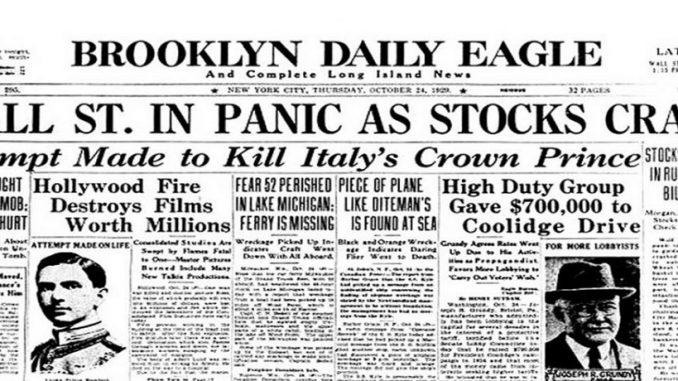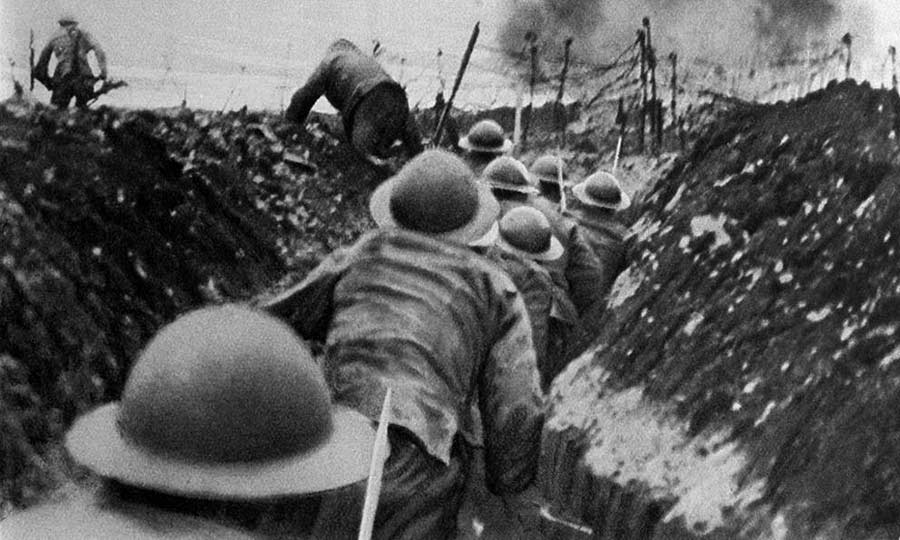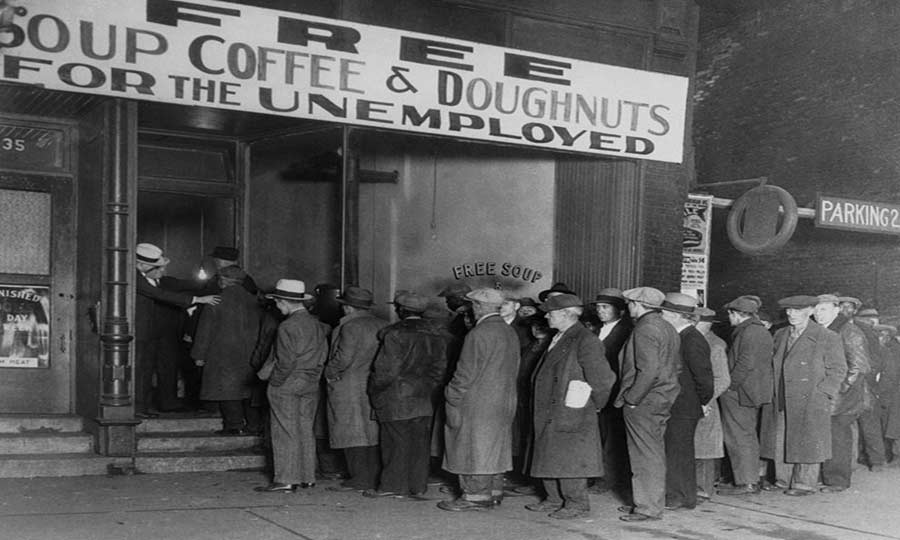
By Carlos Carcione
The crisis of the capitalist system that has been developing since 2008 and that reached dramatic levels due to the pandemic, brought once again the comparison with the Crash of 1929. A comparison made by international institutions like the IMF, scholars, analysts and more or less progressive intellectuals to warn us about the depth of the current crisis. But what was the crisis of 1929? How and why it happened? What consequences did it have and what lessons did it teach us? Here is a look from the revolutionary socialist militancy.
In October of 1929, the greatest economic crisis to date in the history of capitalism breaks out. The 24th of that month would go on history as Black Thursday as the stock market of Wall Street crashes and the main shares loose on average 40% of their price. Five days later, Tuesday the 29th, the crash repeats itself causing a crisis that would spread to the entire world and would last almost a decade. This phenomenon, known as the Great Depression, would only begin to recede with World War II. The crash of the stock market was followed by a collapse in the banking industry and then a huge fall in production, employment and investment. The number banks insolvency reached an annual average of 600 institutions during the 1920’s, while in the 30’s, after the stock market crash, it reached an annual average of 1,350 banks bankrupt. This phenomenon reached its peak in 1933 when around 4,000 banks filed for bankruptcy. A third of American banks filed for bankruptcy in the period of 1930-1933. Unemployment soared to 25% of the whole work force and thousands of small “investors” were left in ruins, world trade shrunk by half and protectionist phenomena developed that accelerated the expansion of the crisis to the rest of the world. The panic scenes, suicides in the middle of Wall Street, long queues of jobless people looking for a job or food in all the cities of the North American country, the faces that were sad due to hunger of the mothers with their children –marvelously depicted by Dorothea Lange—are the graphic expression of that period. The outburst of the crisis is the symbol of how while economic growth generates more social inequality, the crisis of the system also beats the most unprotected people.
“The Booming Twenties”
Similar to the bankruptcy of 2008, very few predicted the crash of 1929. “The Happy Twenties” or the “Roaring Twenties”, comparable to the European Belle Epoque, since the end of the 19th century to the beginning of the Great War, were a period of prosperity and continuous celebration for the privileged sectors in the United States. Unlike their European allies in World War I, that country came out stronger, while Great Britain, the dominant empire till then, and France came out terribly devastated from the armed conflict; meanwhile Germany was overwhelmed by the debts of the war, the sanctions and the reparations imposed by the winners. This would be a golden era characterized by strong speculative investment, easy credit that nurtured an indebtedness of the families that would turn out unpayable, a process that would hit rock bottom in October of 1929 after the devastating collapse of the Wall Street stock market. The dramatic consequences of the economic crisis of 1929 would soon be unleashed: unmeasurable economic losses, more than 4,000 banks filing for bankruptcy and millions of working families in ruins. The situation of the rise of speculative markets, known as Big Bull Market that developed in the years prior to the collapse, rested on an extremely fragile base. The crash makes visible the social disaster that we previously mentioned.
However, the financial crisis was not the cause of the depression that lasted a decade. On the contrary, it was the most evident symptom of an economic and social crisis and an inter-imperialistic conflict for world domination that had been brewing for a while and that the World War I was not able to solve. By the end of that crisis, a new geopolitical map was created, with World War II in the midst of it.
The geopolitical dimension that emerged from the Great Depression
In the spring of 1916, Lenin wrote in Switzerland his work “Imperialism, the Highest Stage of Capitalism”, which would have its first edition in autumn of that same year. In his work, he took a true X-ray of the transformations of capitalism as a social system, but also from the point of view of the most developed national States. In this work, the man that a barely year later would become the main leader of the Russian Revolution studies, as meticulously as he could with the information he had in the middle of the War, the transformations in the economy of England, Germany and the United States, the three most powerful countries at the time. The characterization of the transformation of the previous merchant capitalism into a monopolist capitalism and the geopolitical prediction made in 1914 that the open period led to an era of crisis, wars and revolutions, has material foundations in that transformation of the economic structure of capitalism.

The exit from the first great crisis of capitalism on record, which happened in 1870, created the conditions for the development of Germany as a country of modern capitalism which to sustain its industrial development increasingly needed more markets and colonial control that had to be snatched from the dominant United Kingdom. An inter-imperialist conflict emerged for the control of the markets and those colonial spaces that led to the Great War, with its consequence being the destruction of production forces, capital and millions of casualties. Towards the end of the war, in 1918 the previous great pandemic appeared, the Spanish Flu. The flu was carried to Europe by the military forces of the United States, who only definitely joined the war when it was already decided.
The German attempt to access colonies and new markets for its industrial products was defeated, but the cost was extremely high for the British Empire, hegemonic till then, while an expectant and passive participation during most of the conflict allowed the United States to come out unscathed and growing in that conflict. However, the contradictions that caused the war were not solved. England could not keep maintaining its former position of predominance and the United States, despite being the first economy of the world since then, refused or was unable to take the place the United Kingdom was leaving vacant.
United States: rise and decline
At the same time: Lenin’s prediction kept coming true. Not only the war had broken out, but also the first triumphant workers’ revolution appeared, the Russian Revolution. The triumph of the republic of the Soviets in the civil war in their land, added a strong element of international questioning of capitalism. The German Revolution of 1918, which rose again in 1923, allowed the confirmation of that prediction. However, the defeat of the German revolutions, as well as the Biennio Rosso in Italy between 1919 and 1920, among other processes, would enable the rise of fascism and prolong the crisis of the system. The exhaustion of the triumphant European countries in the war, the situation of dismay, misery and hunger of the German mass movement imposed by the Treaty of Versailles, the rise of Nazism; the mistakes of the first and the subsequent Stalinist betrayal to the German process, as would happen after the Spanish Civil War, cleared the way, besides the strengthening of fascism and the rise of Hitler to power, for rearmament and the dynamic towards a new war.

The economic growth of the United States almost without interruption for half a century stumbles with the Crash of 1929 and the Great Depression that had been incubating in the previous period, opening a decade of greater crisis, instability and social polarization. But its situation as a dominant country forces it to take a leading role when World War II breaks out. The end of the war, as occurred at the end of the First, presents a situation in which it has to assume its hegemony, and with the cooperation of the Stalinist USSR it crushes the open revolutions in various countries of Europe, although it cannot prevent the end of the colonial world. However, this country establishes itself as the hegemonic capitalist power.

In the period after the World War II, the recovery takes place. This time known as the Golden Age lasts until the end of the 60s and beginning of the 70s. The recovery has economic and political reasons. Firstly, the monumental destruction of productive forces during the period of the Great Depression and the war itself which required a huge reconstruction effort. But on the other hand, once Nazism was defeated, the revolutionary rise of the mass movement takes place once again. This process could be diverted and in some cases frozen by the counter-revolutionary role of Stalinism. A third element that marked the destructive mutation of the system was the industrial boost based on a strong arms industry. But the dynamism of the system only reached the end of the 1960s.
An exhausted system
Between 1845 and 1846 Marx and Engels, as part of their work to break with idealism and classical political economy, produced The German Ideology. In the text they affirm that, at some point in their development, the productive forces of capitalism become its opposite, forces of destruction. For the same period, in the Communist Manifesto they point out that the historical justification of all social formation is given by the development of its productive forces and that when these cease to develop it is the historical time of the replacement of the old society by a new one. Almost ninety years later, in the Transitional Program, the founding document of the Fourth International, one year before the outbreak of the Second World War and 10 years after the Crash of 1929, Trotsky affirms that this moment has arrived long ago. From then on, the conditions for the replacement of a decadent society by a new one do not cease to mature. On the contrary, he says, those conditions are rotting.
If by the end of the World War II, the threat on mankind was a nuclear holocaust, today in its decline the system becomes more predatory and parasitic. With a fierce extractivism, it destroys the planet, exhausts sources of limited resources, makes fertile lands sterile and uses up vital elements like water. It tries by all means to increase the overexploitation of labor and raises to unprecedented levels the inequality and fictitious capital, the waste of natural resources in an anarchic and wasteful production. It causes social pandemics such as forced migrations and natural disasters that threaten the very survival of life.
In these conditions of capitalism, we can only to wait for dramatic crises like that of 1929, 2008 and the current one. Two world wars; triumphant, defeated and frozen revolutions; dozens of regional wars; expropriation of rights won by the workers and the masses of the world. Hunger, misery and unemployment, in addition to growing destruction of the planet and its vital resources; genocides with which it provokes an orgy of blood, are the irrefutable testimony of the exhaustion of the capitalist system. The urgency to replace in a revolutionary manner a system that has no recovery with a new one, socialism, is becoming more and more current.

Pandemic, crisis, new revolutions and inter-imperialist confrontations
The pandemic of COVID-19, put on paper again the exhaustion of the capitalist system. At this point in the development of the pandemic there is consensus that the voracious capitalist expansion has facilitated the leap from the wildlife virus to that of human society. The expansion of the extractive frontier, the preferred mode of production of capital, is the reason.
But in spite of this suicidal mode of production, plundering and destroying nature and man; all the elements present in the crash of 1929 are in force and more acute in this period. An imperialism exhausted and worn out with its military spending eating away at its guts. A threatening rising power, more than by its own will through the logic of history. An unprecedented economic crisis confirmed by the noises of this end of 2020 again on Wall Street, where fictitious capital has reached levels twenty or more times higher than the productive economy, and the panic that the movements of the ruling class transpire.
On the other hand, for a year now, an uncontrollable rise of the mass movement has been going around the world like the communist ghost that once haunted Europe. On the five continents, beginning with the main country on earth, the United States, they are going out to fight for the rights they know they deserve and they are winning victories, partial ones it is true, but victories in the end. History does not repeat itself. But analogies are useful to find common elements from the past with which to read as accurately as possible the current reality. Therefore, when we look from today’s crisis at the senile and decrepit face of imperialism in all its civilizing aspects, both Western and Eastern, and of capitalism as a system; what we see is the gloomy image in the mirror of the Great Depression and the Crash of 1929. Our task is to build the revolutionary political tool with which the workers as a class, the youths and the popular masses can destroy this corrupt regime and win the emancipation of humanity.








